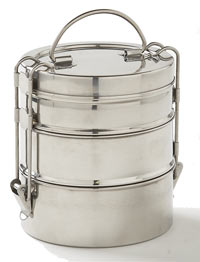
Now this is really genius. I think it’s obvious that I am of the “live to eat” variety, but there is nothing more dreadful and than figuring out what to do about lunch during the work week (or school week). There are really so many days in a row you can eat a turkey sandwich (or spinach salad) and it’s never high on the priority list when you’re busy to come up with an alternative that doesn’t take much time to prepare, is more cost effective than buying lunch and actually sparks some enthusiasm. So, if you’re like me, it’s easy to fall into the trap of buying your lunch – which can get expensive, unhealthy and is never quite as good as something homemade.
Enter the tiffin dabawallah system of Mumbai. I first was introduced to the concept when Gordon Ramsay, one of my favorite celebrity chefs, implemented a tiffin system during an overhaul of an Indian restaurant on his show Kitchen Nightmares. Although it appears the tiffin system was ultimately unsuccessful in that instance, its Mumbai origins prove the concept can flourish.
So, here’s the idea: you pay a modest fee for your lunch and a dabawallah (a tiffin carrier) brings you a hot, freshly cooked and delicious meal to your workplace during lunch. When you’re done, you place your tiffin box outside your home that night, where it is picked up and reused for your lunch over and over again.
OK, this is a vast oversimplification of a lunch delivery system that is complex but whose genius lies in the simplicity of the concept. This system has served Mumbai’s city workers for over a century and has been praised world-wide for its “astonishing” efficiency. After some quick research, it is apparent that some attempts inevitably have been made to bring this concept to the U.S., but with mixed success.
Iain Aitch of The Guardian describes what a typical Indian tiffin box may hold:
The traditional Indian tiffin box consists of several stacked aluminium boxes with a carry-handle, each box containing individual portions of meat and vegetable curry dishes, bread, rice and, usually, something sweet. In your tiffin box you might find dishes such as daal, roti, paratha, yoghurt and sabji, or takes on the roadside “tiffin” of India, such as aloo papdi chaat – potatoes, chickpeas and onions with yoghurt, tamarind sauce and chutney.
Sounds good to me!



